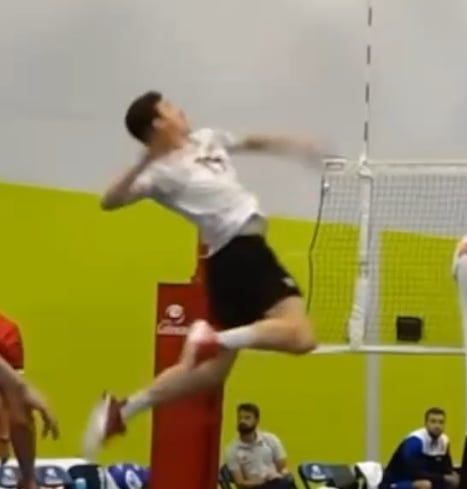This spring I’m doing 3 different running article series.
On Tuesday, I’m releasing articles aimed at giving you a small, specific tool to make your in-practice or in-match coaching more effective. On Fridays, I’m writing about ways to increase the physical capability of players. On Sundays, I’m releasing a more statistically-oriented beach article.
Last week we talked about measuring spike velocity. We want to hit hard and we need to start by measuring how hard we hit.
Okay, simple enough, but what sort of training do we need to do to hit harder? From a fitness perspective, I question that there’s a ton of traditional “weight room” stuff that’s going to transfer to hitting. Sure, gaining some muscle probably helps just because the physics of collision mean that a ball will rebound harder off a heavier human than a lighter human. But we’re talking pretty marginal gains there and besides, added weight can be counterproductive to jumping higher and moving faster.
A lot of what needs to happen comes from rotational power. Building that is a bit more complex and, because it’s a high-velocity movement, there’s only so much that slow-speed movements will transfer. So a lot of the building of rotational power is going to happen on court.
But there’s also a huge collision on contact that your body needs to handle. And your rotator cuff is what needs to handle that collision. You’re probably familiar with various band exercises for the rotator cuff. They may have some uses. In this book John Kirsch lays out some of what causes shoulder pain in the rotator cuff and what some of the solutions are. Or should I say, THE solution, because there seems to be one exercise that has an overwhelmingly positive effect on the shoulder.
Hanging.
Yep, just get up on a pull-up bar and… hang there. Do that a bunch and there’s all sorts of great adaptations that happen in the rotator cuff. Kirsch provides MRI examples, etc.
The cool thing about hanging is that it’s also an indicator. If you notice a theme here, I really like physical training where the training is a test and vice versa. If your shoulder is jacked up, you will struggle to hang for even 30 seconds. As you work hanging into your training and you can start to hang for 1-min+ with no problem, your shoulder will start to feel better.
Then, once you unlock 1-arm hanging, you’re really in business.
I also like hangs because they are idiot-proof. It takes 2 seconds to explain and minimal equipment to do. Your kids can’t mess it up. They won’t hurt themselves. It’s also cool because a hang can be part of your warmup to engage your rotator cuff and warm your shoulder up. It can also be part of the cooldown for athletes whose shoulders get tight and need to restore range of motion after a practice.
My programming recommendations:
Once per week, do a challenging hang workout. Start with 2 sets of 30 seconds or so. Progress as you can until you’re doing 4 sets in the 60-90s range. Once you get into the 60-90s range, you should be close to doing a 1-arm hang. Don’t do 1-arms until you can get at least 10 seconds. Once you can do 1-arms for 30+ seconds, check out some of the progressions in the video below.
Every other practice session, do a “half and half” hang as part of (ideally) both warmup and cooldown. What I mean by this is do half the volume for half the time. So if you did 2 sets of 60 seconds in your main workout, do 1 set of 30 seconds before and after training. If you did 4 sets of 90 seconds, you would do 2 sets of 45s. Don’t worry about getting your calculator out. The point is to keep some additional stimulation to your rotator cuffs without maxing out every practice.
Easy enough huh? Give hangs a try.
This was a short freebie article. If you want more than an hour of diving into the nuances behind improving arm health and velocity, check out the seminar I did with Nick Del Bianco and Mischa Harris last year. It’s one of the most popular sessions I’ve ever done. Nick and Mischa touch on quite a few progressions and regressions for hanging as it’s one of the foundations of their training programs.
Armswing Mechanics
This previous Monday we held a live seminar on Armswing Mechanics with Nick Del Bianco and Mischa Harris from Athlete Wellness Academy. 20+ premium subscribers were able to attend live and many more of you emailed questions ahead of time. Nick and Mischa packed a ton of content into 90 minutes. This was one of the longest and densest seminars we’ve ever done. Just a ton of awesome stuff here.



Good stuff Joe! Have been telling athletes for years that the best way to strengthen and protect their shoulders is brachiation and crawling patterns. Easy to learn, very low injury potential, can be done almost anywhere, and drastically changes an athletes strength.